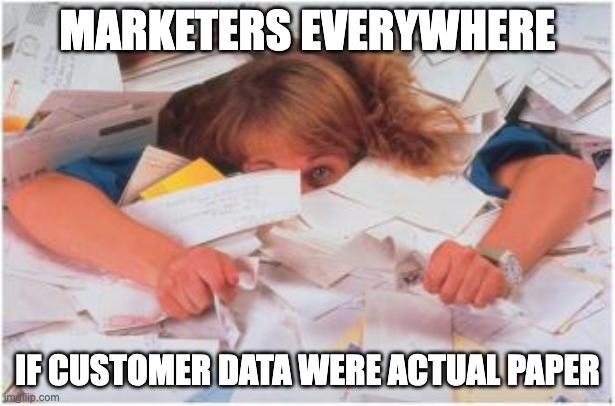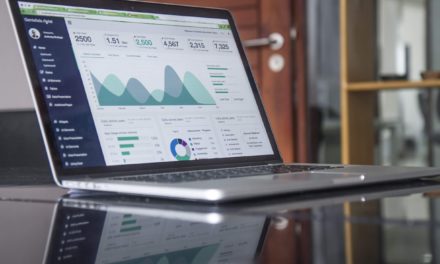Hey, got data? No doubt you do. The question is, where you got data?
In a lot of organizations, customer data tends to linger in varying systems used by departments ranging from sales to customer service to product development to, obviously, marketing.
Then there’s all the data customers leave behind every time they interact with your company via an ever-growing list of channels and devices, like apps, web browsers, SMS, chatbots, mobile devices, social media platforms, emails and more. WHEW!
According to a 2019 survey, 54% of companies say their biggest barrier to leveraging data is that it’s so often fragmented and siloed, preventing an accurate and integrated view of the customer journey.
Enter the Customer Data Platform (CDP), one of the fastest growing categories of marketing tech. CDPs exist partly because other martech (e.g., automation systems) couldn’t keep pace with the data explosion from the sheer amount of online and offline channels customers interact with.
CDPs are able to ingest data from multiple sources and systems (less gross than it sounds, hopefully). Then they organize it into individual customer profiles. So, they solve that pesky little data fragmentation and access problem. Sound cool so far? Good. Let’s go deep with CDP.
Tell me more – what exactly is a CDP now?
Here it is, straight from the Customer Data Platform Institute (yes, there is such a thing):
“A customer data platform (CDP) is a collection of software which creates a persistent, unified customer database that is accessible to other systems. Data is pulled from multiple sources, cleaned and combined to create a single customer profile. This structured data is then made available to other marketing systems.”
Now let’s pick apart that cute lil’ Webster-worthy definition:
Data is pulled from multiple sources. A CDP can connect to in-house systems and data sources, such as email systems, CRM, call center databases, and marketing automation platforms, to gather demographic and transactional data on customers. They can also collect behavioral data from digital channels like social media platforms, websites and ad impressions.
Data is cleaned and combined to create a single customer profile. After capturing data from all these sources, the CDP de-clutters it and links it to specific customers (or accounts).
Structured data is then made available to other marketing systems. The CDP provides a centralized location where clean, organized data is accessible to third-party marketing systems, ready for use in campaigns, without a high level of IT or data engineering involvement.
Why we care: CDPs eliminate data silos and generate a single customer view
A CDP can integrate with organization-wide systems to get in-house data under control, readying it for use by other tools. They also, as mentioned, can gather behavioral data from customer interactions through channels like apps, websites, live chat and others.
Through an algorithm-fueled process called identity resolution, the CDP matches all these types of data to individual customer identities.
And ta-da: you gain the in-house capability to build a single customer view – that super-important concept crucial to improving campaign ROI, conversion, retention, engagement and basically just, you know, crushing it.
This is all terrific, but how are marketers actually taking advantage of the key benefits of CDP?
A CDP’s tools and capabilities put marketers in the driver’s seat regarding all aspects of omnichannel campaigns. They give marketers ownership over the data, which can remove significant barriers.
Barriers in the form of time delays – for example, waiting for the involvement of data science or IT teams. Or budget constraints related to outsourcing personalized campaigns to a digital agency.
More specifically, here are some goals and end results associated with optimizing campaigns with CDPs:
Segment customers into target audiences. CDPs (good ones) let marketers build segments of customers who share traits or behaviors that qualify them to receive specific communications. For example, segment contacts who have indicated they’ll see a budget increase, prospects who have visited a product page but have yet to buy, or contacts you’ve had a relationship with for a certain number of years. The possibilities are nearly limitless!
Deliver more individualized personalization. Then, use what you now know about these customers to talk to them in a relevant way that incites action. Obvs, right? You gain insight into behavior, intent, engagement, interaction with your brand, product/services or your team…opportunities to personalize, unlocked.
Orchestrate the customer experience. According to a 2021 survey by CDP platform vendor Segment, 73% of customer data decision-makers say a CDP will be critical to customer experience efforts. By tracking behavioral interactions and continuously adding that data into the single customer profile, marketers can follow the customer journey in real-time. Then you can more precisely time outreach like offers, invitations to learn more, or a personal call from a sales rep. And ensure that these efforts don’t bump into each other. (Cuz that’s awkward.)
Position other teams for strategic decision-making. By collecting and organizing high-level insights on customer behavior and attributes, CDPs can inform other teams on strategy and direction: product developers, finance teams, and even C-suite roles, for example.
Get a better grip on data privacy. A CDP’s core functions – finding and linking data related to specific customers and storing it in one centralized location – support compliance with General Data Protection Regulation (GDPR) requirements.
A customer data platform is different from a CRM
CDPs and CRMs both collect and manage customer data, but differ in function and the end goals they serve. Again, a CDP collects data from multiple online and offline sources, then autonomously compiles it to form unified customer profiles.
A CRM, on the other hand, stores first-party data logged by team members. CRMs record a customer’s or account’s interactions with the company. CRMs are primarily associated with tracking the sales pipeline, providing a place for team members to record customer interaction data that helps reps improve outreach and build relationships.
A CDP won’t replace a CRM. But they can integrate, feeding each other important customer data that will optimize the performance and usefulness of both platforms.
Also, don’t confuse CDPs with DMPs
Data management platforms (DMPs) are definitely not synonymous with CDPs, despite the fact that two out of the three words in their names are the same. They, too, differ in the type of data they collect and their purposes:
CDPs collect first-party data with identifiers like names and email addresses. Conversely, a DMP collects anonymous third-party data from services and providers that reflect customer identifiers, like cookies and IP addresses.
CDPs support multiple marketing functions, while DMPs are used for ad targeting and audience building. Like with CRM, CDPs and DMPs can integrate and share data.
If you’re considering CDP…
So, to review: CDPs are built for marketers as end-users. They solve data fragmentation, providing a single customer (or account) view to enable finer segmentation, superior marketing orchestration and strong personalization tactics.
When you put it that way, why NOT jump right into the CDP waters? Back up from the end of the diving board a sec and consider a few things:
- Evaluate your current data management systems and processes. Knowing what you already have in place is important.
- Prioritize use cases and goals. What are the key objectives – getting customer data centralized? A more seamless customer journey across channels? User behavior-driven campaigns? Enhancing ad spend? Make sure that a CDP will help you get there better than your current tech.
- Consider how to get buy-in. Securing C-level buy-in rests on showing organization-wide benefits – so outline how a CDP’s can result in wins for the whole company.
Gartner’s four CDP categories & top vendors
Gartner groups CDP vendors into four categories:
Marketing Cloud CDPs include established players like Adobe, Microsoft, Oracle and Salesforce, who have added CDP in response to demand. If your marketing team already uses one of these, it might make sense to go with that product’s CDP offering.
Smart Hub CDPs emphasize marketing orchestration and personalization from a single interface. They’re a good choice for marketers who want to strengthen customer experiences right off the bat – but aren’t looking for super-deep technical functionality. Examples include BlueConic, Lytics and Redpoint.
Marketing Data Integration CDPs are designed for optimal control over data. They’re known for having robust APIs and data governance capabilities but still being user-friendly for marketers. Marketers who work closely with data and development teams might do best with this type of CDP, as this Future of Commerce article suggests. Tealium is a leader in this category.
CDP Engines and Toolkits, which are platforms that enable unique company builds of data profiles and have less focus on marketing capabilities.
Check out these CDP selection resources:
- Gartner Peer Insights for user reviews on top CDP platforms
- Capterra for vendor-neutral guidance
And finally, remember: only the Lone Ranger gets a silver bullet
Did anyone know that’s where that expression comes from? The Lone Ranger?
As marketers, we’re not Lone Rangers. It’s true that technology like a CDP holds a ton of promise. But they’re only as powerful as the human brains behind them.













